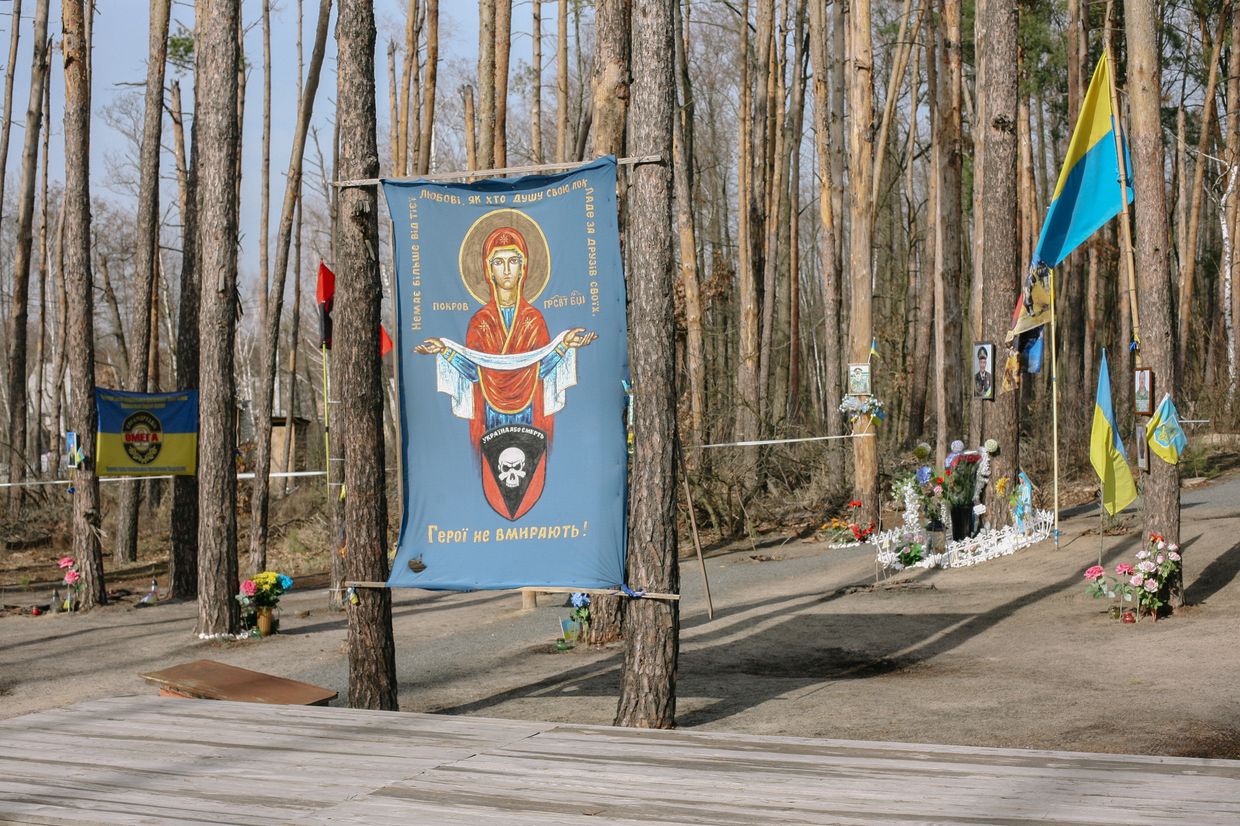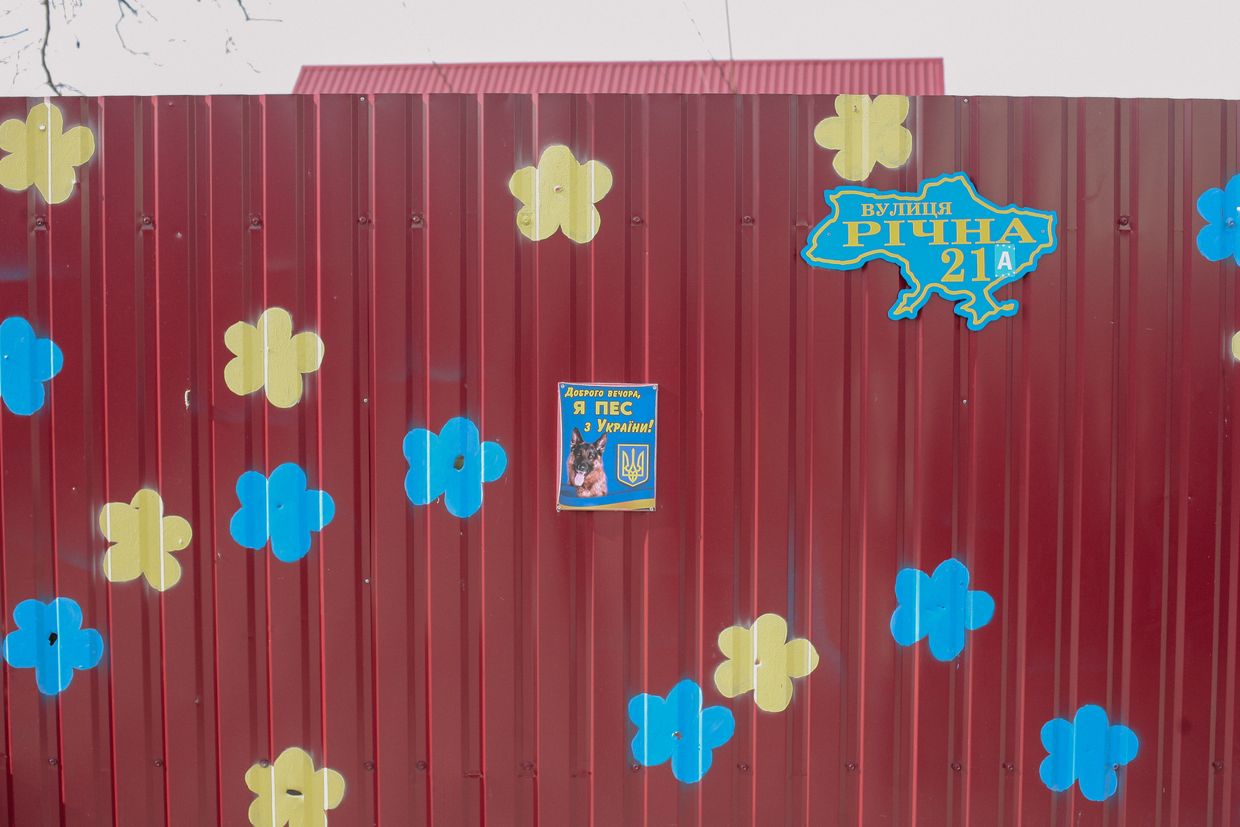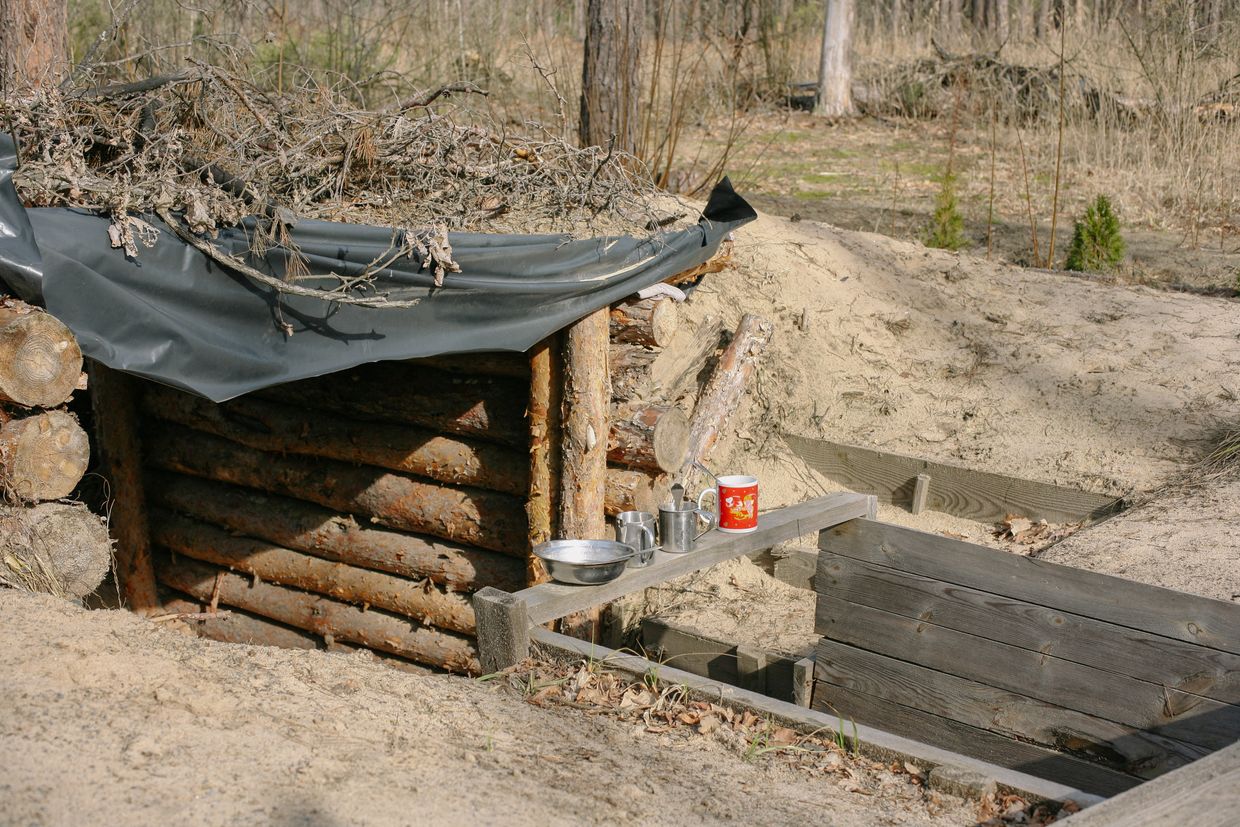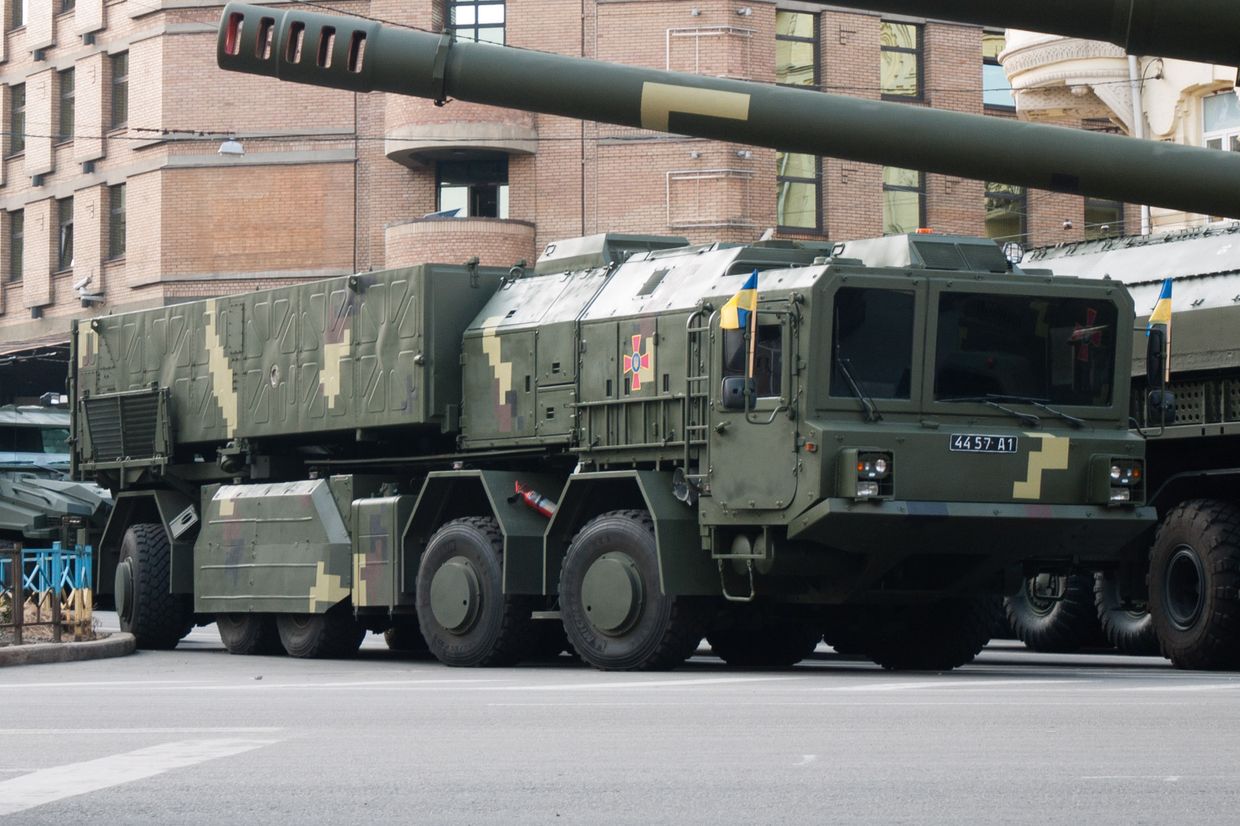Driving out of Kyiv the roads tell the dark history of the early days of Russia’s full-scale invasion. A low buzzing sound echoes across the highway as hundreds of cars drive toward the suburb of Bucha.
“It’s from tanks and heavy vehicles. They left these cuts in the asphalt that produce this creepy sound,” tour guide Svet Moiseev told the Kyiv Independent on a tour on Feb. 27.
Moiseev has told the same fact to dozens of tourists since launching a war tourism excursion shortly after Russian troops retreated from Kyiv Oblast on April 3, 2022, leaving behind decimated towns and villages.
The Kyiv local, who works for Capital Tours, saw an opportunity to utilize his decade-long experience as a guide to inform foreigners about Russia’s brutal invasion and raise money for the war effort.
He crafted an emotional route through the Kyiv suburbs of Bucha, Irpin, Hostomel, and Borodyanka telling intricate stories of Russia’s attempt to capture the capital and the brutal occupation.

He also mixes into the tours Ukraine’s history explaining the country’s centuries-long struggle against Moscow to a largely North American and western European audience. It’s important that people understand that Kyiv is not part of a “big Moscow,” he said.
Ukraine’s tourism industry predictably plummeted after Russia’s invasion. The initial flurry of journalists and political delegations who came to the country following the invasion has also died down as visitors have migrated elsewhere.
But as tourists gradually begin to return, the sector has adapted by offering war tourism opportunities. Not everyone is excited about showing foreigners the scars of war — some locals balk at the idea of displaying their most vulnerable moments to tourists.
Moiseev said he’s noted an uptick in tourists. The first wave arrived in the summer of 2022 and peaked in the summer of 2023 with one or two tours a day. His clientele is a mix of business professionals, political figures, people visiting friends, and curious tourists, he told the Kyiv Independent.
“People want to understand how (this war) could happen in the 21st century. And, of course, they want to pay tribute to those who were killed and those who defended.”
‘Shock therapy’
As business is currently not profitable, Moiseev said he sees himself more as a volunteer doing important work by informing visitors about the Russian occupation.
Tours start at $120, half of which is donated to the Ukrainian army, and the company operates without any support from organizations.
While some of his guests purely want a historical tour of Kyiv, others are eager to spend half a day in the capital’s liberated suburbs. Most tourists are empathetic and genuinely want to learn about the war but Moiseev admitted that a few were simply thrill seekers.
For Moiseev, it's important to show the reality of war to those who have never experienced it in the hopes it will educate people about Ukraine’s plight and increase support for the country abroad.
“This destroyed apartment block is a bucket of ice-cold water on your head to bring it back into reality,” Moiseev said, pointing to a five-story apartment building torn apart by an aerial bomb.
“It's shock therapy for those who forget that the war in Ukraine is still ongoing.”
Reconstruction work has largely brought these formerly-occupied areas back to life, but Moiseev believes in keeping some of the damaged buildings as a “sad museum.”
He draws parallels to Chernobyl, one of Ukraine’s most popular tourist destinations which Capital Tours would visit pre-2022. Both serve as informal museums that remind people of horrific incidents, he said.
For tourist Daniel Hosie, Moiseev’s tour was an opportunity to better understand a war he had been following daily from his native Scotland. Seeing with his own eyes the destroyed bridge in Irpin that Ukraine blew up to prevent Russia’s advance across the Irpin River was a striking moment.
“It was surreal. That bridge is a memorable one for me, because I saw it fall, and I remember thinking that this is crazy. And then I’m there, seeing it,” he told the Kyiv Independent.
Uncomfortable stares
Moiseev interweaves personal stories from locals alongside technical battle details. In one story he tells on the tour, a family in the town of Hostomel outside of Kyiv were forced to hide in a Soviet-era bunker next to their house, braving the 30-meter dash home to gather supplies as shells rained down.
Not everyone wants their life to be turned into a tourist attraction. Signs have appeared on derelict houses warning visitors not to enter or take photographs.
Standing inside the charred remains of his kitchen, Hostomel resident Serhii Ahiyev said that he is wary of guides capitalizing on his bombed-out street.
“Sometimes they bring tourists on purpose to make money from it. Not to talk about what happened,” he told the Kyiv Independent.
Ahiyev does, however, support the idea of drawing attention to the Russian occupation. While he was irritated by the flocks of journalists and visitors in the early days of the liberation, he has since changed his mind and believes people should see the “terrible actions of the Russians,” including tourists.
As a visitor, Hosie believed it was important to visit the satellite towns to get the full experience of Ukraine during the war. But he noted feeling uncomfortable when faced with the grim reality of occupation.
“I didn't want it to be an Instagram photo shoot. You have to show respect,” he said.
“These are people's lives, people's homes. I was aware to keep that in the back of my mind, that this isn't a holiday. You're here to see what's going on and experience it.”
Moiseev himself is often conscious of the stares from locals during tours but still believes that it is important to show foreigners, comparing it to a tour of Auschwitz.
“Most people understand that international support comes from knowledge and information. So (locals), for the most part, tolerate the visitors.”
Humanitarianism and tourism
Tourism can also provide tangible help by supporting salaries and bringing in foreign currency, according to project manager Mykhailo Cherevyk from Visit Ukraine, one of Ukraine’s foremost tourism websites.
In 2022, the company regularly assisted journalists and political delegations, connecting them with locals and charity organizations. But with attention shifting away from Ukraine, tourists now make up 80% of Visit Ukraine’s clients.
In the high season last year, 20 to 30 people per month used Visit Ukraine’s services which range from insurance to tours.
Three months ago, the company launched an experimental project called “Donation Tours.” For just under $2,000, the project combines traditional tourism with a humanitarian mission while partnered with a local guide in southern Ukraine.
Visitors are shown around the city of Mykolaiv, before undertaking a medical training course in the afternoon. The next day, local guides take them to the oblast’s formerly occupied territories where they distribute aid to either medical facilities, children's centers, animal shelters, or provide heating equipment and construction materials, depending on their choice.
The idea was born out of a conversation between Visit Ukraine and a humanitarian center in Mykolaiv, to help meet the needs of residents. Many of the local guides have no prior experience in tourism but know the safe routes to ensure guests are well protected.
“It is one of the ways to resolve the problems that we have with tourism and life in the south of Ukraine,” Cherevyk said, adding that the region has suffered immensely from the invasion.

For now, the idea is too radical for most, with only one or two bookings a month. But Visit Ukraine plans to increase marketing and collaborate with international organizations to attract more people.
“We are working to make sure that more people can see the things that the Russian army does to Ukrainian lands and people. And provide help for southern regions,” Cherevyk said.
The future of Ukrainian tourism
The State Agency for Tourism Development is not actively encouraging international tourism at the moment. But it is using the break to develop domestic tourism, which has increased in western Ukraine.
“We have huge losses, but at the same time we have possibilities for some new destinations to enter the tourism market,” Chairperson of the agency Mariana Oleskiv told the Kyiv Independent.
The agency calculated that tourist taxes contributed Hr. 1.89 billion ($49.2 million) in the first six months of 2021, making up roughly 3% of Ukraine’s GDP that year. Now, western regions primarily hold up the tourism sector as Ukrainians opt to vacation in the Carpathian mountains or previously little-visited cities like Chernivtsi in the southwest.
Developing western regions for Ukrainian tourists will in turn prepare Ukraine for the eventual return of foreigners, according to Oleskiv.
She noted that popular destinations like Lviv became successful following a steady influx of Ukrainian tourists over the years which built its reputation as a hotspot for foreigners. By 2019, international tourists amounted to 50% of Lviv’s tourism market.
The agency believes that war tourism will be a major attraction once travel is safe. Currently, they are developing commemoration routes to mark the horrors inflicted by Russia, from the massacres in Bucha to torture chambers and destroyed infrastructure, like the Irpin bridge.
“If you see it on TV, it's a completely different feeling to when you are there. We want to attract a lot of tourists from all around the world to visit those sites to understand a little bit more about this war to prevent such wars in the future,” Oleskiv stressed.
“It’s something we need to do.”
A memorial to fallen soldiers has already opened on the outskirts of Moschun, a village in Kyiv Oblast. Located in a woodland clearing, dozens of photographs of men and women adorn the trees surrounded by shrines, letters, and a large tapestry of an Orthodox Icon.
Shrapnel-damaged mugs and a metal plate also sit in a nearby trench once used by the defenders battling Russian troops.
More of these memorials could soon be established all over Ukraine, particularly in the east, according to Moiseev. They serve both as a reminder for locals and as an educational site for tourists, he said.
But Oleskiv doesn’t want the sole focus to be on the war. The agency is taking inspiration from countries like Croatia which overcame its war-torn reputation to become a tourist destination, selling its culture and landscape while still telling its troubled history.
Ukraine could do something similar, she said, by attracting visitors to its mountains and seaside while injecting stories of the war into tours.
For now, war tours like the one offered by Moiseev are likely to be a brief snapshot of the current time rather than a long-lasting option. Reconstruction has already erased much of Bucha and Irpin’s scars, while Moiseev notes that it also takes an emotional toil.
“It is working now, not as a business, but basically as a remembrance,” he said.
“After it's all finished, we will come back to Kyiv culture, borscht, and normal things.”






















